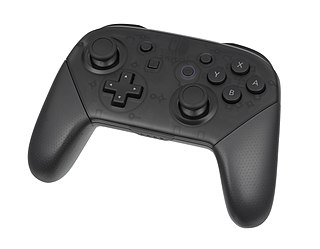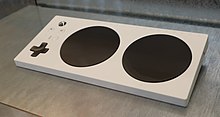
The Gravis PC GamePad is a game port game controller produced by Advanced Gravis Computer Technology first released in 1991. It was the first gamepad for the IBM PC compatible in a market then dominated by joysticks. Included with the gamepad was a shareware Commander Keen game, episode 1, Marooned on Mars, which was later replaced with the shareware episode 4, Secret of the Oracle which supported all 4 buttons. The gamepad is no longer manufactured, as Gravis was acquired in 1997 by Kensington Computer Products Group.

A game controller, gaming controller, or simply controller, is an input device or input/output device used with video games or entertainment systems to provide input to a video game. Input devices that have been classified as game controllers include keyboards, mice, gamepads, and joysticks, as well as special purpose devices, such as steering wheels for driving games and light guns for shooting games. Controllers designs have evolved to include directional pads, multiple buttons, analog sticks, joysticks, motion detection, touch screens and a plethora of other features.

Microsoft SideWinder was the general name given to the family of digital game controllers developed by Microsoft for PCs. The line was first launched in 1995. Although intended only for use with Microsoft Windows, Microsoft SideWinder game controllers can also be used with macOS, Mac OS 9 with third-party software, and Linux.

The game port is a device port that was found on IBM PC compatible and other computer systems throughout the 1980s and 1990s. It was the traditional connector for joystick input, and occasionally MIDI devices, until made obsolete by USB in the late 1990s.

A gamepad is a type of video game controller held in two hands, where the fingers are used to provide input. They are typically the main input device for video game consoles.
In computing, DirectInput is a legacy Microsoft API for collecting input from a computer user, via input devices such as the mouse, keyboard, or a gamepad. It also provides a system for action mapping, which allows the user to assign specific actions within a game to the buttons and axes of the input devices. Additionally it handles haptic feedback (input/output) devices. Microsoft introduced a new input library called XInput specifically for the Xbox 360 controller.
The DualShock is a line of gamepads developed by Sony Interactive Entertainment for the PlayStation family of video game consoles. It is named for vibration-feedback and analog controls. It was introduced in November 1997 as a secondary peripheral for the first PlayStation console. The console's bundle was updated to include DualShock, and phase out the original PlayStation controller and the Dual Analog Controller. The DualShock is the best-selling gamepad of all time by units sold, excluding bundled controllers.
Various accessories for the PlayStation 3 video game console have been produced by Sony and third-party companies. These include controllers, audio and video input devices like microphones, video cameras, and cables for better sound and picture quality.

The Xbox 360 Wireless Headset is a wireless headset designed for the Xbox 360 and Xbox Live; it is manufactured by Microsoft. It can be used for in game voice chat, private chat, audio for video chat and in game voice recognition. Up to four wireless headsets can be used simultaneously on a single Xbox 360. The headset fits over either ear and comes with two sizes of removable earloops for a better fit. It uses the same 2.4 GHz wireless technology as the Xbox 360 Wireless Controller, so it will work within 30 feet of the console. It can achieve up to eight hours of battery life per charge, with an AC wall adapter or a USB DC charger for recharging. USB chargers are readily available from mobile phone accessory shops. The headset can be used with or without a controller. The headset also produces various beeps to signal different actions and give messages to the user. The headset is also compatible for use with a PC via the Microsoft Wireless Receiver. Up to 4 wireless headsets and wireless controllers can be used in conjunction at any one time. The number lit up on the headset will correspond to the quadrant lit up on the controller..

The Xbox 360 controller is the primary game controller for Microsoft's Xbox 360 home video game console that was introduced at E3 2005. The Xbox 360 controller comes in both wired and wireless versions. The Xbox controller is not compatible with the Xbox 360. The wired and wireless versions are also compatible with Microsoft PC operating systems, such as Windows XP, Windows Vista, Windows 7, Windows 8, Windows 10, and Windows 11.

Kinect is a line of motion sensing input devices produced by Microsoft and first released in 2010. The devices generally contain RGB cameras, and infrared projectors and detectors that map depth through either structured light or time of flight calculations, which can in turn be used to perform real-time gesture recognition and body skeletal detection, among other capabilities. They also contain microphones that can be used for speech recognition and voice control.
VRPN is a device-independent, network-based interface for accessing virtual reality peripherals in VR applications. It was originally designed and implemented by Russell M. Taylor II at the Department of Computer Science of the University of North Carolina at Chapel Hill. VRPN was maintained and supported by Sensics while it was business. It is currently maintained by ReliaSolve and developed in collaboration with a productive community of contributors. It is described more fully at vrpn.net and in VRPN-VRST.
Rhythm game accessories are often required to play rhythm games available for various consoles, such as the PlayStation 2, PlayStation 3, Wii, and Xbox 360. These include dance pads, guitar controllers, drum controllers, microphones and turntable controllers. With the exception of microphones, these controllers can generally be used to control any game, but have limited inputs, making them impractical for most games.

Xbox is a video gaming brand that consists of five home video game consoles, as well as applications (games), streaming service Xbox Cloud Gaming, and online services such as the Xbox network and Xbox Game Pass. The brand is produced by Microsoft Gaming, a division of Microsoft.

The Xbox One is a home video game console developed by Microsoft. Announced in May 2013, it is the successor to Xbox 360 and the third console in the Xbox series. It was first released in North America, parts of Europe, Australia, and South America in November 2013 and in Japan, China, and other European countries in September 2014. It is the first Xbox game console to be released in China, specifically in the Shanghai Free-Trade Zone. Microsoft marketed the device as an "all-in-one entertainment system", hence the name "Xbox One". An eighth-generation console, it mainly competed against Sony's PlayStation 4 and Nintendo's Wii U and later the Switch.

The Xbox Wireless Controller is the primary game controller for the Xbox One and Xbox Series X/S home video game consoles, also the official controller for use in Windows-based PCs, and compatible with other operating systems such as macOS, Linux, iOS, and Android. The controller maintains the overall layout found in the Xbox 360 controller, but with various tweaks to its design, such as a revised shape, redesigned analog sticks, shoulder buttons, and triggers, along with new rumble motors within the triggers to allow for directional haptic feedback.

The Xbox Series X and Xbox Series S are the fourth generation of consoles in the Xbox series. Released on November 10, 2020, the higher-end Xbox Series X and lower-end Xbox Series S are part of the ninth generation of video game consoles, which also includes Sony's PlayStation 5, released the same month. Both superseded the Xbox One.

Amazon Luna is a cloud gaming platform developed and operated by Amazon. Available only in the United States, United Kingdom, Canada, Germany, France, Italy, and Spain, the platform is powered by Amazon Web Services, has integration with Twitch, and is available on Windows, Mac, Amazon Fire TV, iOS as well as Android. Luna offers access to a selection of games via the Luna+ subscription as well as to channels from brands such as Ubisoft+ and Jackbox Games.













